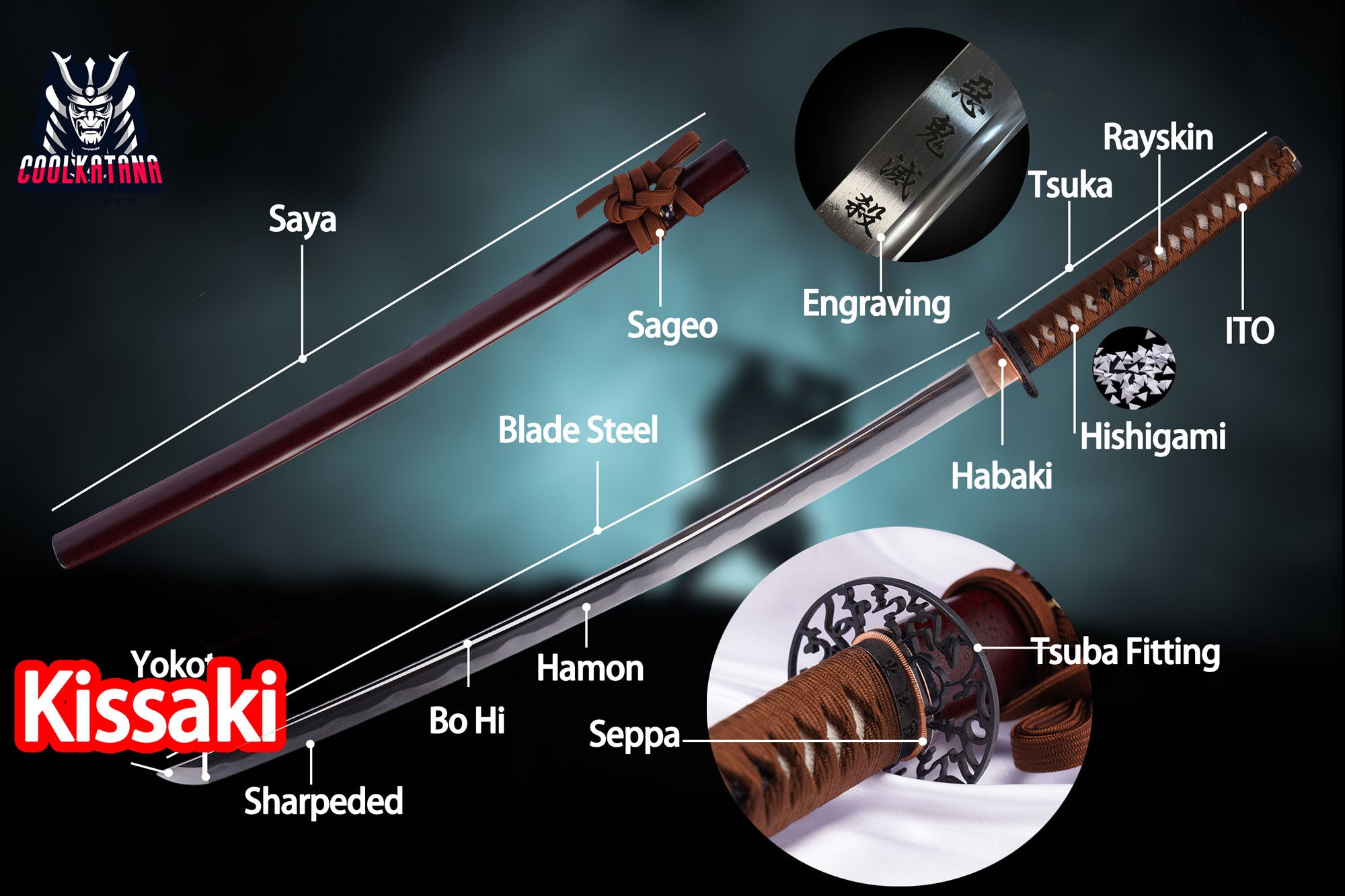Analysis of Katana Kissaki Types: CHU, KO, O, Kamasu Features

What is Kissaki Sword?
Kissaki (切先) refers to the tip or point of a Katana (Japanese sword). It plays a crucial role in determining the sword's cutting ability, piercing power, and overall performance. The shape, angle, and length of the Kissaki vary depending on the sword’s intended purpose and the swordsmith’s preferences. There are different types of Kissaki, each offering unique characteristics suited to specific combat or aesthetic needs. The most common types include CHU-Kissaki, KO-Kissaki, O-Kissaki, and Kamasu Kissaki.
1. CHU-Kissaki (中切先)
CHU-Kissaki is the most commonly used type of tip for traditional katana, offering a balanced shape that is neither too sharp nor too flat. It is typically located at the middle of the blade and has a moderate curvature, making it ideal for various combat situations.
Characteristics and Advantages of CHU-Kissaki:
- Balanced Cutting Power: The moderate angle of the blade tip provides excellent cutting force and precision, suitable for a wide range of combat styles.
- Versatility: Performs well for slicing, cutting, and thrusting, making it ideal for multiple battle scenarios.
- Classic Aesthetics: CHU-Kissaki is the standard for many traditional katana, offering a timeless aesthetic appeal.
Ideal Usage:
- Best suited for traditional katana, especially for collectors and enthusiasts of classic Japanese swords.
- Suitable for both cutting and thrusting in various combat situations.

2. KO-Kissaki (小切先)
KO-Kissaki refers to a smaller, more pointed tip, typically found on shorter swords or lighter blades. This design makes the sword tip extremely sharp and well-suited for precise thrusting and quick slashes.
Characteristics and Advantages of KO-Kissaki:
- Sharp Cutting Power: The small, sharp tip excels in thrusting and precise strikes, especially for close combat.
- Ideal for Quick Attacks: KO-Kissaki is perfect for rapid, accurate strikes in short-range combat.
- Lightweight and Agile: Compared to other Kissaki types, KO-Kissaki offers greater maneuverability and flexibility.
Ideal Usage:
- Best for short swords or ninja swords (Ninjato, Shinobigatana), especially in close-quarter combat or surprise attacks.
- Suitable for users who need high precision and maneuverability.

3. O-Kissaki (大切先)
O-Kissaki is characterized by a larger and blunter tip, often seen on long swords. This design enhances the stability and durability of the sword tip, making it ideal for powerful, heavy strikes.
Characteristics and Advantages of O-Kissaki:
- Enhanced Stability: The larger, broader tip increases the sword’s overall stability, making it highly reliable during heavy strikes.
- Powerful Slashing: O-Kissaki is perfect for delivering strong, decisive cuts, especially when facing opponents with strong defenses.
- Durability: The broad design of the tip makes it less prone to damage, offering excellent durability even during intense combat.
Ideal Usage:
- Ideal for swords that are used for powerful slashing, especially against opponents with strong defenses.
- Common in traditional long katana, perfect for users who prioritize durability and cutting force.

4. Kamasu Kissaki for Ninjato or Shinobigatana (鲛切先)
Kamasu Kissaki features a unique hook-shaped tip, often used in ninja swords (Ninjato) or Shinobigatana. This distinctive design enhances the sword's cutting and piercing abilities, making it highly effective for stealthy, swift attacks.
Characteristics and Advantages of Kamasu Kissaki:
-
Fish-Hook Shaped Tip
The hook-shaped tip is the most notable feature of Kamasu Kissaki, allowing for better penetration and cutting efficiency. This design enables the sword to pierce through tough defenses easily, particularly effective against armored or heavily defended targets. -
Increased Ripping Power
The curved tip of Kamasu Kissaki generates more ripping force, allowing the sword to cut through flesh with greater ease. This is especially useful for slashing attacks where a traditional straight tip might struggle. -
Ideal for Quick Strikes and Stealthy Attacks
The shape of the Kamasu Kissaki makes it perfect for rapid, stealthy thrusts. It allows for swift, precise strikes to vital areas, making it ideal for ninja swords and surprise attacks. -
Enhanced Agility and Mobility
Given the lightweight and agile nature of ninja swords, Kamasu Kissaki enhances their maneuverability, making it easier to strike or evade in close combat. -
Aesthetic and Practical
The unique hook design not only serves a practical function but also contributes to the sword's visual appeal, giving it a distinct and artistic look.
Ideal Usage:
- Ninjato and Shinobigatana: Kamasu Kissaki is a signature design for ninja swords, ideal for assassination, ambush, and rapid attack scenarios.
- Close-Combat: Its unique design excels at close-quarters combat, allowing the wielder to deliver fast, devastating strikes.
- Stealth and Precision: Perfect for situations requiring high mobility, surprise, and precision, particularly in stealthy or covert missions.

www.coolkatana.com
Conclusion:
The Kissaki plays an essential role in determining the performance and aesthetics of a katana. From the balanced CHU-Kissaki to the sharp KO-Kissaki, the powerful O-Kissaki, and the stealthy Kamasu Kissaki, each type of Kissaki offers unique advantages that cater to specific combat styles and needs. Understanding the differences between these types helps sword enthusiasts and collectors choose the right katana based on their intended use, whether for cutting, thrusting, or stealthy attacks.
By selecting the ideal Kissaki type, users can optimize their sword’s performance while also appreciating its aesthetic value. Whether you're a collector, a martial artist, or a practitioner of stealth techniques, the right Kissaki design enhances your experience with the sword.

